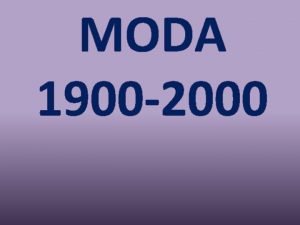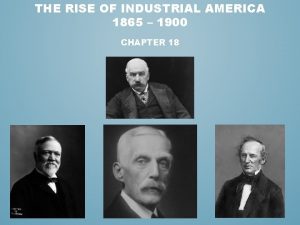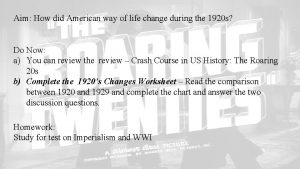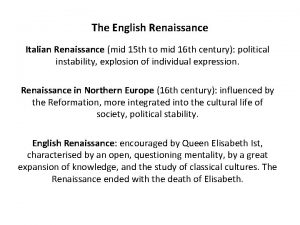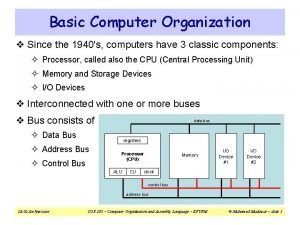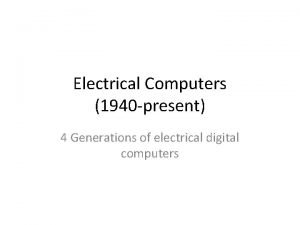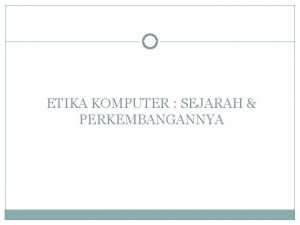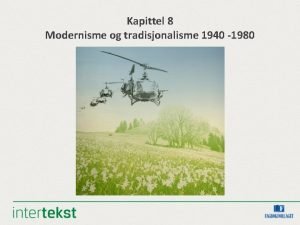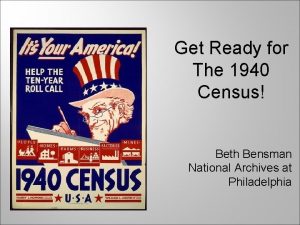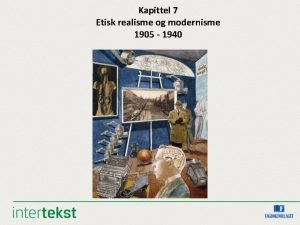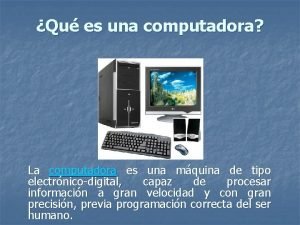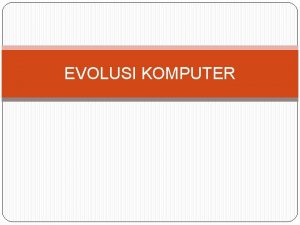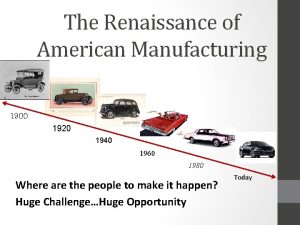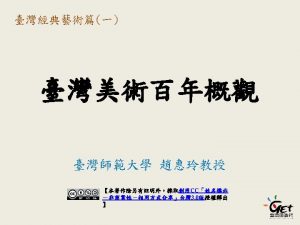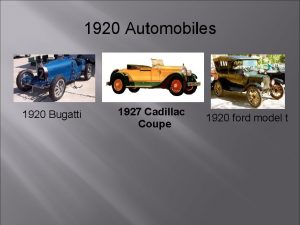The Renaissance of American Manufacturing 1900 1920 1940





































- Slides: 37

The Renaissance of American Manufacturing 1900 1920 1940 1960 1980 Where are the people to make it happen? Huge Challenge…Huge Opportunity Today

Huge Shortage of Skilled Trades • Is there anyone in the audience who doesn’t believe the shortage of skilled manufacturing people is real? • The “shortage story” is old news. • The bigger question is how did we get here and how do we recover? • Manufacturers and Academics. Why do we have such a shortage of manufacturing talent?

Manufacturing History Starting with World War II • American Mobilization of the entire workforce • Rosie the Riveter • Higgins Industries grew from a small business to providing 8, 865 of the Navy’s 14, 072 vessels in 1943. • The average Ford car had 15, 000 parts and the B-24 Liberator longrange bomber had 1, 550, 000 parts. One B-24 off the line at Ford Motor Company ‘s Willow Run plant every 63 minutes. • The Manhattan Project began with a $6, 000 budget and by the end of the war employed 130, 000 workers and had spent $2. 2 billion. • The “Greatest Generation” Delivered

Sailor and girl in Times Square The End of World War II

Who Were the Best Manufacturers in 1947? • Wrong question. • Who were the only significant manufacturers in 1947? • Every other country’s manufacturing facilities had been destroyed. • Americans manufactured products and shipped them all over the world. For twenty years, we had no competition. • We thought we were fabulous manufacturers.

American Manufacturing Reality • Our arrogance closed our eyes to the emergence of manufacturing excellence coming from Japan and Germany. • U. S. Management and Labor fought constantly. • Remember what we said in the 60’s and 70’s about the new cars from Japan and Germany?

Japanese Share of U. S. Auto Market American Auto Makers Japanese Auto Makers

Historical Market Share vs. Arrogance

Video Clip #1 • Flint Factory Closing


Political Support for Manufacturing • In the middle of this gutting of the manufacturing sector, where were our politicians? • Cheap consumer goods for everyone vs. protection for the manufacturing sector. • Free Trade Policy. Unfortunately not a Fair, Free Trade Policy. • Service Industry. Information Industry. “Manufacturing is dead. The end of the Industrial Revolution. ”

Here’s what our intellectual elites had to say about the issue.

Rise of the Service Economy and the Information Age “Potato chips, computer chips, what’s the difference? A hundred dollars of one or a hundred dollars of the other is still a hundred dollars. ” Michael Boskin, Chairman, Council of Economic Advisors 1992

Rise of the Service Economy and the Information Age “When a fast-food restaurant sells a hamburger, is it providing a service or combining inputs to manufacture a product? . . . the distinction is blurry. ” Dr. N. Gregory Mankiw, Chairman, Council of Economic Advisors. 2004

Video Clip #2 • Taco Bell

Rise of the Service Economy and the Information Age “A successful argument for a government manufacturing policy has to go beyond the feeling that it’s better to produce “real things” than services. American consumers value health care and haircuts as much as washing machines and hair dryers. ” Christina Romer, 4 February 2012 NYT, former Chairwoman of President Obama’s Council of Economic Advisors.

Here’s the context for the decision for your son or daughter to go into manufacturing.

1990 -2010 Decisions, Decisions…. • If you’re a talented student thinking about your future, is manufacturing top of mind? • If you’re the parent of a talented student, are you advising them to go into manufacturing? • If you’re the high school guidance counselor, are you advising any of your talented kids to go into manufacturing? • Combine this with the American mantra of “If you want to be successful, you have to go to a four year college. ” The answer to all three questions is a resounding NO!

So What? • That was then, this is now. • America can’t have a manufacturing revival without people to make it happen – all the people. • Everyone in a manufacturing facility has to contribute. • The good old days of “Tom says…. . ” doesn’t work.

Soft Skills Essential • Teamwork • Problem solving • Attitude • The sum of the individual team members capabilities = the strength of the team. • What’s the strength of our human capital to join today’s team?

The 2012 PISA assessment showed US 15 -yearolds scoring below average in math and science (compared to students from 64 other countries and systems) 600 520 496 498 501 495 497 481 480 440 400 Reading Literacy Mathematics Literacy OECD Average Science Literacy US 2013 Program for International Student Assessment results from nces. ed. gov Analysis by Susan Perkins Weston 560

23 rd in Reading Literacy 34 th in Mathematics Literacy 27 th in Science Literacy Shanghai, Hong Kong, Shanghai, Singapore, Hong Shanghai, Hong Kong, Singapore, Japan, Republic of Kong, Chinese Taipei, Singapore, Japan, Finland, Korea, Finland, Ireland, Republic of Korea, Japan, Estonia, Republic of Korea, Chinese Taipei, Canada, Liechtenstein, Switzerland, Vietnam, Poland, Canada, Poland, Estonia, Netherlands, Estonia, Liechtenstein, Germany, Liechtenstein, New Zealand, Finland, Canada, Poland, Chinese Taipei, Netherlands, Australia, Netherlands, Belgium, Germany, Vietnam, Ireland, Australia, Macao. Belgium, Switzerland, Macao Austria, Australia, Ireland, China, New Zealand, -China, Germany, Vietnam*, Slovenia, Denmark, New Switzerland, Slovenia, United France*, Norway*, United Zealand, Czech Republic, Kingdom* France, United Kingdom, Austria*, Belgium*, Latvia*, Iceland, Latvia, Luxembourg, France*, Denmark* Norway*, Portugal*, Italy*, Spain*, Russian Federation*, Slovak Republic* * Marks a score difference that is not statistically significant Analysis by Susan Perkins Weston …. and outscored by key economic competitors

Educational Testing Service Study • ETS Research Forum: America’s Skills Challenge: Millennials and the Future • Literacy • Numeracy • Problem solving in technology rich environments • 22 Participating countries

ETS Study Con’t How do the average scores of U. S. millennials compare with those in other participating countries? • Literacy – Only Spain and Italy had lower scores. • Numeracy – US tied for last with Spain and Italy • PS-TRE – US tied for last along with Slovak Republic, Ireland Poland

ETS Study Con’t How do millennials with different levels of educational attainment perform over time and in relation to their peers internationally? • Since 2003 the percentage of US millennials scoring below level 3 (Minimum) in numeracy increased at all levels of education attainment. • U. S. millennials with a 4 year bachelor’s degree scored 20 th out of 22. • Millennials with a master’s or research degree scored 19 th out of 22.

Manufacturer’s Challenge #1 • Changing the perception of manufacturing. No longer dirty, dark and dangerous. • Manufacturing today is sophisticated and high tech. • Manufacturers need to engage the academic community differently than we have historically. • For talented young adults, this is an opportunity of a lifetime.

Manufacturer’s Challenge #2 • Finding young adults: • • With brains and a decent education Who are drug free Who have a desire to work as part of a team Who are not entitled • In other words, “Hey Dude” doesn’t get it.

Manufacturers and Educators Must Join Together • Most manufacturers have turned their backs on the labor shortage issue preferring to hire from others. • We need to challenge educators to think differently about how to educate kids so they’re work or college ready when they graduate high school. • Approximately 25% of the $1. 2 Trillion in college debt is remedial education to get students ready to start college. • The AMT model is outstanding and will serve as an example for other industries. • Ford’s Next Generation Learning is another “mold-breaking” model with great success. What are some of the potential obstacles of manufacturers working effectively with educators?

Educators and Manufacturers Different Perspectives? 1. Tangibility and Political Behavior 2. Cost Management 3. The Urgency Quotient

Tangibility Continuum Tangible Farmer Intangible Rabbi or Priest

Tangibility Continuum Tangible Manufacturer Intangible College Professor

Intangibility and Political Behavior Political Apolitical Intangible Tangibility

Educators and Manufacturers Different Perspectives? 1. Tangibility and Political Behavior 2. Cost Management 3. The Urgency Quotient


$25, 000 $10, 000 71 -72 72 -73 73 -74 74 -75 75 -76 76 -77 77 -78 78 -79 79 -80 80 -81 81 -82 82 -83 83 -84 84 -85 85 -86 86 -87 87 -88 88 -89 89 -90 90 -91 91 -92 92 -93 93 -94 94 -95 95 -96 96 -97 97 -98 98 -99 99 -00 00 -01 01 -02 02 -03 03 -04 04 -05 05 -06 06 -07 07 -08 08 -09 09 -10 10 -11 11 -12 12 -13 13 -14 14 -15 The Cost of a College Education $35, 000 $30, 000 Private Nonprofit. . . Public Four-Year Annual Growth Rate 5. 8% $20, 000 Annual Growth Rate 8. 9% $5, 000 $0

Urgency Quotients • Group Discussion about the cost per hour of shutting down Toyota, GE, Siemens or Ford.

Summary 1. It took 30 to 40 years to dig this hole. It’s going to take awhile to recover. 2. From a manufacturer’s perspective, the education model has to evolve to deliver graduates who can quickly add value to the organization and later become the next generation of manufacturing leaders. • The soft skills are essential. 3. Educators and manufacturers need to work together as partners recognizing we have different skill sets. 4. Manufacturing will be an extraordinary opportunity over the next 30 or 40 years. • Kids and their parents are beginning to get it.
 Nursing research chapter 1
Nursing research chapter 1 Moda 1910
Moda 1910 The rise of industrial america 1865-1900
The rise of industrial america 1865-1900 American way of life 1920
American way of life 1920 Manufacturing cost vs non manufacturing cost
Manufacturing cost vs non manufacturing cost Additive manufacturing vs subtractive manufacturing
Additive manufacturing vs subtractive manufacturing Job costing with process costing
Job costing with process costing Controllable costs
Controllable costs Manufacturing cost vs non manufacturing cost
Manufacturing cost vs non manufacturing cost The renaissance outcome the renaissance in italy
The renaissance outcome the renaissance in italy Northern vs italian renaissance art
Northern vs italian renaissance art Cosimo de' medici
Cosimo de' medici Renaissance vs high renaissance
Renaissance vs high renaissance Italian renaissance vs northern renaissance venn diagram
Italian renaissance vs northern renaissance venn diagram Italian renaissance vs english renaissance
Italian renaissance vs english renaissance The renaissance introduction to the renaissance answer key
The renaissance introduction to the renaissance answer key The renaissance outcome renaissance painters/sculptors
The renaissance outcome renaissance painters/sculptors Sejarah komputer sebelum 1940
Sejarah komputer sebelum 1940 Camaro 1940
Camaro 1940 Suomen olympialaiset 1940
Suomen olympialaiset 1940 Computer since the 1940s
Computer since the 1940s Edvac full form
Edvac full form Ethicomp dan cepe
Ethicomp dan cepe Tungetaledebatten modernisme
Tungetaledebatten modernisme Baltic states 1940
Baltic states 1940 Self portrait with monkey 1940
Self portrait with monkey 1940 Boye kallocain
Boye kallocain Edhint
Edhint 1925-1940
1925-1940 Japanese empire 1940
Japanese empire 1940 Sumbangan mohammad eunos abdullah
Sumbangan mohammad eunos abdullah 1940 moda
1940 moda Historiske hendelser mellom 1905 og 1940
Historiske hendelser mellom 1905 og 1940 Que es una computadora
Que es una computadora 1950 luvun muoti
1950 luvun muoti Komputer 1940
Komputer 1940 1930-1939 fashion
1930-1939 fashion Educational act of 1940
Educational act of 1940

